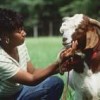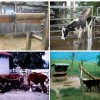 In general, infested animals are unhealthy and cannot be managed efficiently, so pesticides are commonly used to protect animals from pests. The successful control of pests requires careful mixing and application of recommended pesticides according to label directions. Besides ensuring the control of pests, applying pesticides at the recommended rate is necessary to prevent injury to the animal. This 5-page fact sheet was written by P. E. Kaufman and E. N. I. Weeks, and published by the UF Department of Entomology and Nematology, October 2012.
In general, infested animals are unhealthy and cannot be managed efficiently, so pesticides are commonly used to protect animals from pests. The successful control of pests requires careful mixing and application of recommended pesticides according to label directions. Besides ensuring the control of pests, applying pesticides at the recommended rate is necessary to prevent injury to the animal. This 5-page fact sheet was written by P. E. Kaufman and E. N. I. Weeks, and published by the UF Department of Entomology and Nematology, October 2012.
http://edis.ifas.ufl.edu/ig128
Tag: Livestock Pest Management
Self-Treatment Methods for Livestock–Backrubbers (ENY279/IG134)
 Back rubbers are a method of pesticide self-treatment for cattle. When bothered by insects or other pests, cattle tend to rub against objects. Backrubbers provide a rubbing surface that is treated with a pesticide. Cattle self-treat during rubbing, which reduces the number of flies, particularly horn flies, and parasites such as lice, on the animal. Backrubbers may be purchased commercially or constructed from easily available materials. A properly designed backrubber that supplies pesticide reliably to the animal can be a valuable addition to an integrated pest management program. This 4-page fact sheet was written by E. N. I. Weeks and P. E. Kaufman, and published by the UF Department of Entomology and Nematology, September 2012.
Back rubbers are a method of pesticide self-treatment for cattle. When bothered by insects or other pests, cattle tend to rub against objects. Backrubbers provide a rubbing surface that is treated with a pesticide. Cattle self-treat during rubbing, which reduces the number of flies, particularly horn flies, and parasites such as lice, on the animal. Backrubbers may be purchased commercially or constructed from easily available materials. A properly designed backrubber that supplies pesticide reliably to the animal can be a valuable addition to an integrated pest management program. This 4-page fact sheet was written by E. N. I. Weeks and P. E. Kaufman, and published by the UF Department of Entomology and Nematology, September 2012.
http://edis.ifas.ufl.edu/ig134
Horn Fly Haematobia irritans irritans (Linnaeus) (Insecta: Diptera: Muscidae) (EENY490/IN885)
The horn fly is one of the most economically important pests of cattle worldwide. Just in the United States, hundreds of millions of dollars in losses are attributed to the horn fly annually, while additional millions are spent annually on insecticides to reduce horn fly numbers. Learn more about this pernicious obligate blood-feeding ectoparasite in this 7-page fact sheet, written by Dan Fitzpatrick and Phillip E. Kaufman, and published by the UF Department of Entomology and Nematology, April 2011.
http://edis.ifas.ufl.edu/in885
ENY281/IG135 Management of External Parasites with Forced-Use Dust Bags
Revised! ENY-281, a 7-page illustrated fact sheet by P. E. Kaufman, P. G. Koehler and J. F. Butler, describes this safe, economical, and effective technique for managing external parasites on cattle in Florida — background, directions for hanging commercial dust bags, safety, cost of treatment, and effectiveness. Includes references. Published by the UF Department of Entomology and Nematology, April 2009.
http://edis.ifas.ufl.edu/IG135